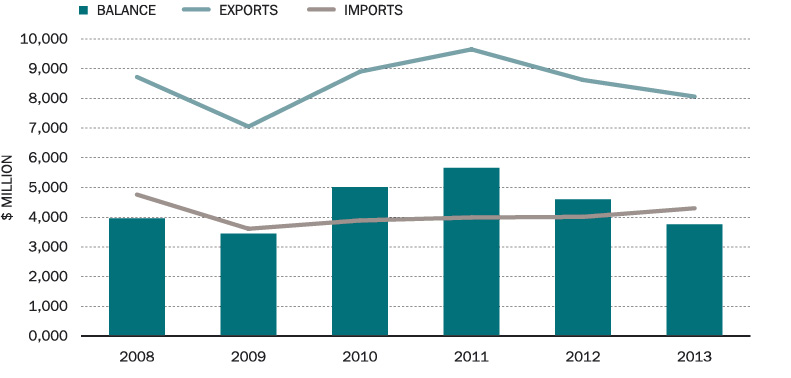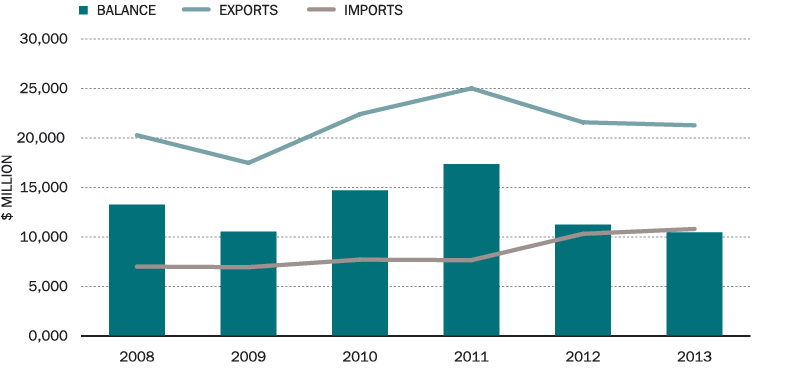1.1(1) North Asia
Overview
Developments in 2013–14 again showed the central security and economic importance of North Asia as tensions rose between China and Japan and in the South China Sea. Australia called on all parties to manage disputes peacefully and in accordance with international law and to avoid actions that could fuel tensions. North Asia is the destination for some 54 per cent of Australian exports and a major source of investment.
We strengthened Australia’s relationships with North Asian partners by facilitating several successful visits by leaders to and from the region. The Prime Minister, Foreign Minister and Trade and Investment Minister visited China, Japan and the Republic of Korea (ROK) to promote closer security and economic ties. The Governor-General made a state visit to China signifying the importance of the relationship at the highest level.
The department promoted security links with North Asia including by establishing new and enhanced cooperative relationships with Japan and continuing high-level exchanges with China and the Republic of Korea. We advocated a peaceful resolution to territorial disputes in the region bilaterally and at a range of multilateral forums, including the East Asia Summit (EAS) and the ASEAN Regional Forum (ARF). We sought to influence the human rights situation in China and North Korea through formal bilateral dialogue and at the United Nations.
We concluded a free trade agreement (FTA) with the Republic of Korea, finalised an economic partnership agreement with Japan and significantly progressed FTA negotiations with China. We pursued our economic diplomacy agenda with North Asian countries in key regional and multilateral bodies, particularly the EAS, and secured their support for our ambitious G20 agenda.
China, Hong Kong, Japan, Mongolia, the Republic of Korea and Taiwan agreed to participate in the New Colombo Plan (NCP) and the first NCP students travelled to Japan and Hong Kong in 2014. (See 1.5.)
| Exports | Exports | Imports | Imports | |||
|---|---|---|---|---|---|---|
| Goods and services | 2012 | 2013 | Trend growth 2008–2013 | 2012 | 2013 | Trend growth 2008–2013 |
| $m | $m | % | $m | $m | % | |
| Total North Asia (b) (d) (g) | 163,790 | 184,859 | 9.4 | 85,309 | 89,224 | 4.4 |
| China (c) (d) | 79,260 | 101,536 | 21.4 | 46,402 | 49,329 | 6.4 |
| Japan (c) (d) | 49,986 | 49,492 | 1.2 | 21,347 | 21,221 | –0.1 |
| Republic of Korea (c) (d) | 21,582 | 21,285 | 2.9 | 10,317 | 10,814 | 10.0 |
| Taiwan (c) (d) | 8,617 | 8,060 | 0.8 | 4,014 | 4,300 | –0.5 |
| Hong Kong (b) (d) | 4,273 | 4,431 | –0.8 | 3,212 | 3,548 | 1.4 |
| Other (b) (d) (e) (f) | 72 | 56 | 0.0 | 17 | 12 | –7.3 |
(a) Goods data on a recorded trade basis, services data on a balance of payments basis.
(b) Excludes selected confidential export commodities from partner country totals from June 2013 onwards. Therefore movements in the confidentialised country totals may not reflect the true pattern of trade.
(c) Actual export total for 2013 based on unpublished ABS data.
(d) Excludes selected confidential import commodities from partner country totals from September 2008 onwards. Therefore movements in the confidentialised country totals may not reflect the true pattern of trade.
(e) Goods data only. Services data is not published by the ABS for these countries.
(f) Other comprises Democratic People’s Republic of Korea, Macau and Mongolia.
(g) Total includes actual export totals for 2013 for China, Japan, Republic of Korea and Taiwan.
Based on DFAT STARS database, ABS catalogue 5368.0.55.004 and unpublished ABS data.
Figure 5: Foreign investment from Asia to Australia
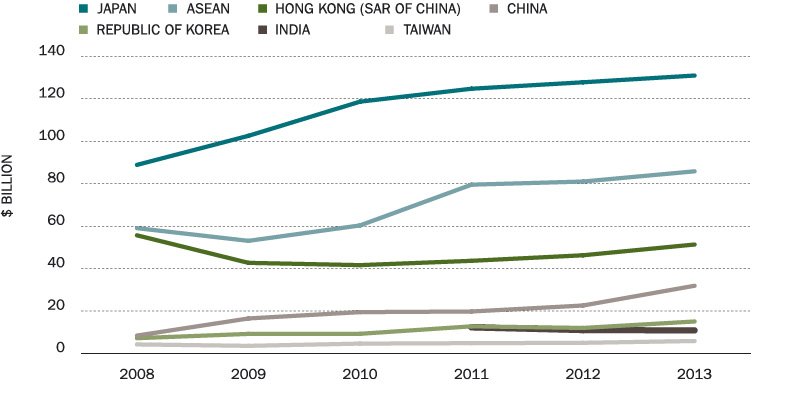
Note: India data is not published from 2007 to 2010 inclusive.
Based on ABS catalogue 5352.0 – International Investment Position, Australia: Supplementary Statistics, 2013
Japan
The department was closely involved in Prime Minister Abbott’s visit to Japan in April 2014, during which leaders confirmed their intention to strengthen the long-standing friendship and elevate the strategic partnership between Japan and Australia to a new special relationship.
The department organised the Foreign Minister’s visit to Japan in October 2013 for discussions with Prime Minister Abe and Foreign Minister Kishida on bilateral security, defence cooperation, the NCP and FTA negotiations. During the discussions Japan agreed to be a pilot country for the NCP. In April 2014, Ms Bishop participated in the Nuclear Non-Proliferation and Disarmament Initiative in Hiroshima.
)%20-%20Bishop%20and%20Kishida.jpg)
Minister for Foreign Affairs, Julie Bishop, and Japanese Foreign Minister, Fumio Kishida, following talks, Tokyo, 15 October 2013. [DFAT]
In line with our economic diplomacy objectives, the department supported Mr Robb’s visits to Japan in November 2013, and March and April 2014 to lead the final Economic Partnership Agreement negotiations. The Prime Minister announced the substantial conclusion of negotiations on 7 April. The Japan–Australia Economic Partnership Agreement is a landmark step in the economic relationship, and will deliver mutually beneficial trade and investment outcomes to both countries (see also 1.1(8)). Japan was Australia’s second-largest trading partner in 2013 and third-largest source of foreign investment.
The department worked closely with the Department of Defence to advance bilateral security cooperation. The fifth Australia–Japan foreign and defence ministerial 2+2 consultations in Tokyo in June 2014 saw agreement on enhancements to the defence and security partnership. The consultations concluded negotiations on a Defence Equipment and Technology Agreement and confirmed timing for the inaugural bilateral cyber policy dialogue. Ministers agreed to the development of a coordinated strategy to improve existing development, security and defence capacity-building, disaster relief, and diplomatic and multilateral cooperation activities in the Pacific.
Both countries undertook to abide by the 31 March decision of the International Court of Justice on Japan’s southern ocean whaling program.
We welcomed Japan’s positive role in the negotiations for the Trans-Pacific Partnership (TPP) and the Regional Comprehensive Economic Partnership (RCEP) agreements, which seek to achieve a comprehensive free trade area in the Asia–Pacific (see 1.1(8)). We also engaged Japanese counterparts to achieve shared economic and strategic objectives in regional and multilateral forums, including the EAS, APEC, the World Trade Organization (WTO), the G20 and the United Nations.
Figure 6: Australia’s trade in goods and services with Japan (a) (b)
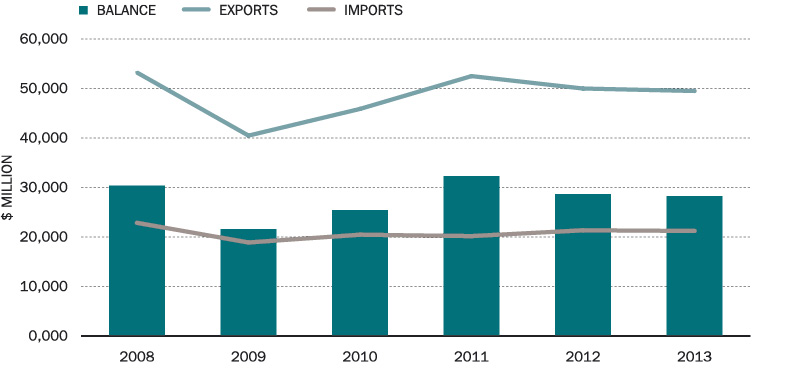
(a) Goods data on a recorded trade basis, services data on a balance of payments basis.
(b) Excludes selected confidential import commodities from September 2008 onwards.
Based on DFAT STARS database, ABS catalogue 5368.0.55.004 and unpublished ABS data.
China
The department consolidated Australia’s bilateral architecture with China to further institutionalise regular high-level meetings. The Foreign Minister met her Chinese counterpart, Wang Yi, for the first time under the new Foreign and Strategic Dialogue structure, highlighting the Government’s commitment to the bilateral relationship. The inaugural Strategic Economic Dialogue took place in Beijing with the Minister for Trade and Investment and the Treasurer meeting the Chairman of China’s National Development and Reform Commission to discuss the bilateral economic relationship.
)%20-%20Adamson%20and%20Robb%20China%20visit.jpg)
Ambassador to China, Frances Adamson (right), accompanies Minister for Trade and Investment, Andrew Robb AO (left), on a visit to an Australian wool processing plant, Wujiang, 24 October 2013. With them are: Michell Wool Chairman, David Michell (second left), and Senior Trade Commissioner to Shanghai, Michael Clifton. [DFAT]
We continued to work closely with China in key regional and multilateral bodies, including the EAS, the G20, the ARF and the UN Security Council. The department coordinated whole-of-government efforts to design complementary agendas between the G20 and APEC during Australia and China’s respective host years.
Total two-way trade rose to a record $151 billion in 2013, a 20 per cent increase on 2012. Total investment flows continued to grow rapidly. Following renewed high-level commitment, we made significant progress toward completion of an FTA (see 1.1(8)). The department continued to play an important role in negotiations on regional and multilateral trade agreements involving China, including RCEP and in the WTO.
The department facilitated a busy agenda of high-level exchanges in both directions. Our portfolio ministers visited China several times during the review period. The Prime Minister conducted a multi-city visit in April 2014, accompanied by three ministers, five state premiers, one chief minister and the most senior Australian business delegation ever to go to China. During this visit, we secured Chinese agreement to become part of the NCP. In October 2013, the department assisted with the Governor-General’s state visit.
In June 2014, China’s Commerce Minister Gao Hucheng came to Australia for the Joint Ministerial Economic Commission and Shanghai Party Secretary Han Zheng visited as a Guest of Government. Assistant Foreign Minister Zhang Zeguang was in Australia in January 2014 for talks with senior officials.
The department continued to advocate improvement to China’s human rights performance. We led the 15th round of the Australia–China Human Rights Dialogue in Beijing and continued our Human Rights Technical Cooperation Program. We made robust recommendations to the UN Human Rights Council on China’s Universal Periodic Review Process.
We opened a consulate-general in Chengdu, our fourth post in mainland China, to establish stronger relationships with provincial governments in the fast-growing central region and to promote Australian commercial interests. We continued to enhance cooperation with key economic regions within China and welcomed the publication by the Australia Guangdong Business Cooperation Council of guidelines for Australian businesses operating in China.
Under the Australia–China development cooperation partnership we made good progress with the co-designing of a joint anti-malaria project in Papua New Guinea to begin in 2015 (see also 1.7). The department also continued to deliver a health system strengthening project in the Tibetan Autonomous Region.
Figure 7: Australia’s trade in goods and services with China (a) (b)
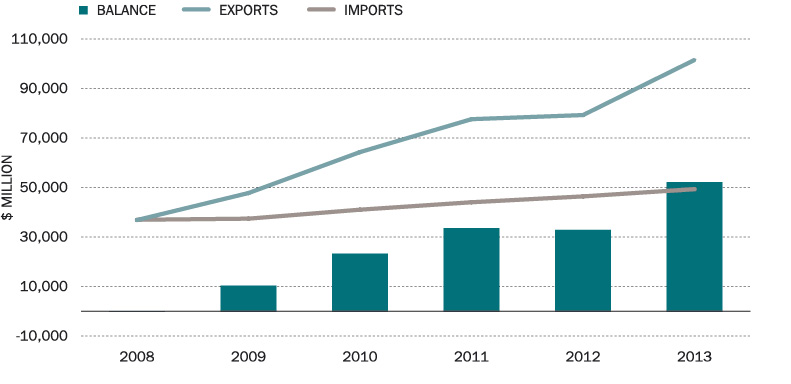
(a) Goods data on a recorded trade basis, services data on a balance of payments basis.
(b) Excludes selected confidential import commodities from September 2008 onwards.
Based on DFAT STARS database, ABS catalogue 5368.0.55.004 and unpublished ABS data.
Australia Week in China
The inaugural Australia Week in China (AWIC) took place from 8 to 11 April 2014. The week comprised around 80 trade, investment, education and tourism promotion events and was the largest Australian trade event held in China to date. Over 700 representatives from 564 organisations participated in the program. The department helped coordinate the signing of 20 separate commercial agreements forecast to generate sales of $894 million.
Minister Robb participated in a range of AWIC activities, including a business seminar and networking session in Chengdu, the opening of the ANZ Bank sub-branch in the Shanghai Free Trade Zone, and an event to showcase Australia’s strengths in the food and beverage and agribusiness industries.
Hong Kong
Hong Kong is Australia’s leading business base in East Asia and our fifth-largest source of foreign investment. The department harnessed the support of this business community to promote Australia as an attractive investment destination and to bolster exports, including education and tourism services.
The department supported Mr Robb’s visits to Hong Kong in October 2013 and March 2014, and facilitated his engagement with prominent investors. During Ms Bishop’s visit in October 2013, Hong Kong agreed to participate in the NCP pilot. Parliamentary Secretary to the Minister for Foreign Affairs, Brett Mason, launched the pilot in Hong Kong in May 2014.
Taiwan
Taiwan was Australia’s seventh-largest merchandise export market in 2013, worth $7.4 billion. The department actively promoted Australia’s credentials as a reliable supplier of minerals and energy, and encouraged greater Taiwan investor interest in Australian resource projects. Formosa Plastics Group’s $1.26 billion investment in Fortescue Metal’s Iron Bridge iron ore project was the largest Taiwanese investment in Australia to date.
The Bilateral Economic Consultations hosted by the department in June 2014 delivered outcomes on two-way tourism and confirmed Taiwan’s participation in the 2015 rollout of the NCP. The two sides signed an MOU on the exchange of data on invalid passports which strengthened border security by preventing misuse of lost and stolen passports.
(a) Goods data on a recorded trade basis, services data on a balance of payments basis.
(b) Excludes selected confidential import commodities from September 2008 onwards.
Based on DFAT STARS database, ABS catalogue 5368.0.55.004 and unpublished ABS data.
The Republic of Korea
The department worked for robust economic relations with the Republic of Korea, our fourth-largest trading partner and third-largest export market. These reached a new level with the conclusion of negotiations on the Korea–Australia Free Trade Agreement (see 1.1(8)).
Following the end of these negotiations, we resumed Joint Economic Committee meetings among senior officials to discuss a strategic approach to realising economic, trade and investment opportunities in line with the FTA. While the stock of ROK investment in Australia increased from a very low base to $US15.1 billion in 2013, the Republic of Korea is still only the seventeenth-largest foreign investor in Australia. And while the Republic of Korea is currently Australia’s third-largest international student source and our eighth-largest inbound tourism market, our aim is to boost the ROK investment profile and increase trade in services.
The department finalised establishment of 2+2 security talks between defence and foreign ministers. Australia is only the second country after the United States to hold 2+2 security talks with the Republic of Korea. Ms Bishop visited in October 2013 to attend the Seoul Conference on Cyberspace and to discuss security and economic relations with ROK leaders.
The department supported intensified cooperation with the Republic of Korea at multilateral forums including the UN Security Council where we were both non-permanent members. We worked closely at international meetings and informal gatherings of the MIKTA middle powers (Mexico, Indonesia, the Republic of Korea, Turkey and Australia). High-level bilateral aid talks in Seoul in May 2014 helped improve coordination of our programs, particularly in the Mekong region.
(a) Goods data on a recorded trade basis, services data on a balance of payments basis.
(b) Excludes selected confidential import commodities from September 2008 onwards.
Based on DFAT STARS database, ABS catalogue 5368.0.55.004 and unpublished ABS data.
Democratic People’s Republic of Korea (North Korea)
The department worked closely with regional partners, including on the UN Security Council, to respond to North Korean threats, provocations and proliferation activities. We urged North Korea to abandon its nuclear weapons and missile programs and comply with its international commitments. We continued to implement UN sanctions on the regime and comprehensively reviewed and updated Australia’s autonomous sanctions. We led international efforts to address the dire human-rights situation in North Korea and worked in the United Nations for a strong response to the Report of the Commission of Inquiry on Human Rights in the DPRK, chaired by former Australian High Court judge, Michael Kirby. The department provided $3 million in humanitarian assistance through the UN World Food Programme to help relieve the suffering of the North Korean people.
Mongolia
The first visit to Australia by a Mongolian foreign minister in over twenty years in February 2014 attested to significant progress in the bilateral relationship.
In Canberra, Foreign Minister Luvsanvandan Bold signed a consular-cooperation MOU and agreed on expanding the Australia Awards Scholarships program in Mongolia. He also endorsed the Australia–Mongolia Extractives Program which will assist Mongolia with the sustainable development of its resources industry.
)%20-%20Mongolia%20consular%20MOU.jpg)
First Assistant Secretary Consular and Crisis Management Division, Justin Brown (second right), and Mongolian Ambassador, Ravdan Bold (second left), are joined by Foreign Minister Julie Bishop and Mongolian Foreign Minister, Luvsanvandan Bold (left), after signing an MOU on Consular Cooperation, Canberra, 18 March 2014. [DFAT]
The department managed $15.3 million in development assistance to Mongolia in 2013–14, up from $14.3 million in 2012–13 (see 1.7). We continued to advocate a transparent and predictable investment environment in Mongolia to reduce poverty and lift living standards.
Outlook
Support for visits by Japan’s Prime Minister Abe and China’s President Xi Jinping will be priorities. ROK President Park is also likely to attend the G20 Leaders Meeting in Brisbane in November.
We will promote stronger economic engagement in the region, including by coordinating whole-of-government cooperation with Japan and the Republic of Korea to implement our new trade agreements. We will work closely with regional partners to garner support for significant outcomes from our G20 host year. We will support China to ensure its APEC host year also delivers tangible outcomes for the region.
We will aim to finalise our FTA negotiations with China by the end of 2014. The department and Austrade will work closely with Australian business to maximise the benefits of the economic partnership agreement with Japan and the FTA with Korea upon their entry into force in 2014.
We will continue to promote increased investment from North Asia into Australia including by facilitating participation from the region in the Northern Australia Investment Forum.
We will support the rollout of the NCP beyond its pilot phase to involve all countries in the region. We will strengthen bilateral tourism relationships with North Asia and increase our engagement in the APEC Tourism Working Group and the OECD Tourism Committee.
We will deepen security links with China, Japan and the Republic of Korea including by encouraging shared participation in military exercises and in disaster response activities. We will work with the region bilaterally and at multilateral forums to press North Korea to cease its weapons-proliferation activities and comply with its international commitments.
Rolling out the extractives aid program will deepen engagement with Mongolia. We also expect to commence regular consultations at senior level with Mongolia’s Ministry of Foreign Affairs and Trade.


